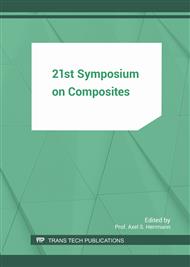[1]
A.S. Herrmann, P. Zahlen, M.I. Zuardy, Sandwich structures technology in commercial aviation, In: Proceedings of the 7th International conference on sandwich structures, Aalborg, Denmark, 2005, p.13–26.
DOI: 10.1007/1-4020-3848-8_2
Google Scholar
[2]
M.I. Zuardy, T.B. Block, A.S. Herrmann, Structural analysis of centre box of a vertical tail plane with a side panel from composite foam sandwich, In: Proceedings of Deutscher Luft- und Raumfahrtkongress, Bremen, Germany, 2011, p.1377–1389.
DOI: 10.1007/s13272-011-0009-5
Google Scholar
[3]
R. Olsson, T.B. Block, Criteria for skin rupture and core shear cracking induced by impact on sandwich panels, Compos. Struct. 125 (2015) 81-87.
DOI: 10.1016/j.compstruct.2015.01.028
Google Scholar
[4]
A.L. Marasco, Analysis and evaluation of mechanical performance of reinforced sandwich structure: X-Cor and K-Cor, PhD Thesis, Cranfield University, UK, (2005).
Google Scholar
[5]
M.A. Dimassi, C. Brauner, A.S. Herrmann, Experimental study of the mechanical behaviour of pin reinforced foam core sandwich materials under shear load, In: Proceedings of the 18th Chemnitz Seminar on Materials Engineering WTK-18, Chemnitz, Germany, 2016, pp.268-275.
DOI: 10.1088/1757-899x/118/1/012012
Google Scholar
[6]
G. Endres, Tied Foam Core Technology and the achieved impact performance of sandwich constructions based on reinforced foam materials, CFK-Valley Stade Convention, Stade, Germany, (2014).
Google Scholar
[7]
M. John, A. Geyer, R. Schäuble, R. Schlimper, Comparing unreinforced and pin-reinforced CFRP/PMI foam core sandwich structures regarding their damage tolerance behaviour, In: Proceedings of the 20th International conference on Composite Materials, Copenhagen, Denmark, (2015).
DOI: 10.1007/s10443-012-9288-1
Google Scholar
[8]
F. Han, Y. Yan, J. Ma, Experimental study and progressive failure analysis of stitched foam-core sandwich composites subjected to low-velocity impact, Polym. Compos. (2016).
DOI: 10.1002/pc.23976
Google Scholar
[9]
F. Xia, X.Q. Wu, J.L. Li, Numerical simulation of impact responses on through-thickness stitched foam core sandwich composite, Appl. Compos. Mater. 20 (2013) 1041-1054.
DOI: 10.1007/s10443-013-9312-0
Google Scholar
[10]
D. Zenkert, The Handbook of Sandwich Constructions, EMAS Publishing, UK, (1997).
Google Scholar
[11]
P.C. Zahlen, M. Rinker and C. Heim, Advanced manufacturing of large, complex foam core sandwich panels, In: proceedings of the 8th International Conference on Sandwich Structures, Porto, Portugal, (2008).
Google Scholar
[12]
Tenax HTS Filamentgarn data sheet, Version 5 30-09-2014, Toho Tenax Europe GmbH Wuppertal, Germany.
Google Scholar
[13]
HexFlow RTM6 data sheet, December 2014 Document-no. ITA 065f, Hexcel Corporation, Stamford, USA.
Google Scholar
[14]
Product information ROHACELL HERO, February 2014-edition, Evonik Industries AG, Darmstadt, Germany.
Google Scholar
[15]
Torayaca T800H data sheet, Document-no. CFA-007, Toray Carbon Fibers America Inc, Santa Ana, CA, USA.
Google Scholar
[16]
M.A. Dimassi, C. Brauner, A.S. Herrmann, O. Focke, Experimental study of the indentation behaviour of tied foam core sandwich structures, In: Proceedings of the 17th European Conference on Composite Materials, Munich, Germany, (2016).
DOI: 10.1177/1099636217748577
Google Scholar
[17]
T.B. Block, Analysis of the mechanical response of impact loaded composite sandwich structures with focus on foam core shear failure, PhD Thesis, University of Bremen, Germany, (2014).
Google Scholar
[18]
Z. Hashin, Failure criteria for unidirectional fiber composites, J. Appl. Mech. 47 (1980) 329-334.
DOI: 10.1115/1.3153664
Google Scholar
[19]
S. Warhus, Experimentelle Kennwertermittlung und numerische Simulation des Crushing-Verhaltens von Pin-verstärkten Sandwichstrukturen, Master thesis, University of Bremen, Germany, (2015).
Google Scholar


